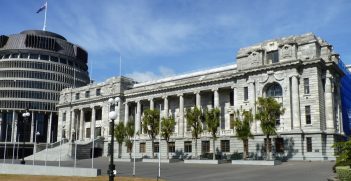NZ Election Roundup: Not Just Jacinda

New Zealand Prime Minster Jacinda Ardern’s Labour Party can govern alone. But the 2020 election was not just down to her successful leadership style, and electoral considerations may see Labour govern moderately over the next three years.
Last Saturday’s general election in New Zealand was not about whether Prime Minister Jacinda Ardern’s Labour Party could retain government—some form of Labour victory was assured—but whether the party could secure an outright majority of seats. Normally this would be unthinkable under the Mixed Member Proportional (MMP) electoral system. Indeed, MMP, which gives New Zealanders one vote for a candidate to represent them in a local electorate and another to decide the ultimate proportion of parties in parliament, was explicitly designed to produce stable coalition government.
Nevertheless, polls the week prior to the election showed Labour likely to capture 47.5-49 percent of the crucial party vote, which made Labour’s result not only possible but likely once wasted votes—votes for parties who fail to achieve either a 5 percent party vote threshold or gain an electorate seat and thus cannot enter parliament—were taken into consideration. Within an hour of the initial count, journalists and other commentators took to Twitter to call the election an outright Labour victory. In the end Labour garnered 49.2 percent of the vote, or 64 seats out of the 120 in parliament, a share that may increase once “special” post-in and overseas votes are considered.
Naturally, most election analysis has pointed to Jacinda Ardern’s competent leadership, clear communication, and empathy in the face of COVID-19 as the main factors behind Labour’s success. A Reid Research Poll as early as May put Ardern’s score in the preferred prime minister rankings at 59.5 percent, the highest in the poll’s history, and as the country’s extreme lockdowns eased the same month, 92 percent of New Zealanders believed the prime minister had made the right call in pursuing an elimination strategy. With those figures, it was hard for the opposition National Party to gain any traction.
But the election was not “just about Jacinda.” National’s downward spiral was partly of its own making. The party caucus deposed its unpopular leader, Simon Bridges, in May, replacing him with relatively unknown Todd Muller who then resigned in July, citing the pressure of the job. Muller’s replacement, Judith Collins, had not supported Bridges in his hour of need, and details of factional infighting within her caucus were leaked to the media by those who had. Ardern’s victory, therefore, is also about National’s disarray. On election night, with their party finishing at 27 percent, National Party commentators and defeated MPs repeated the mantra the pandemic had sunk them, but the party also had itself to blame.
Willing to experiment when they knew their party was going to lose, many National supporters spun off to the nominally libertarian ACT party on the right, which finished third overall. On the night, ACT leader David Seymour, who had previously represented his party alone in parliament, spun his 8 percent of the party vote and 9 new seats as a major victory. Nevertheless, ACT will play a largely ineffectual role this term, and its support will almost certainly be gobbled up when National decides it wants to get serious about governing again.
The Green Party, which had been in coalition with Labour, increased its share of the vote by more than a percentage point, giving it two more seats to total 10. While the increase may seem modest, this is actually an impressive showing: MMP tends to weaken junior parties in power. Leading parties will usually take credit for coalition government success, while using coalition partners as an “excuse” not to deliver on controversial policy that may play to their base but not to the broader public. Career politician Winston Peters, leader of New Zealand First, had earlier positioned his party as a “handbrake” on the ”silly ideas” of an otherwise red-green government. On Saturday, New Zealand First could not muster the support to re-enter parliament. Peters declared that he would be back at the next election in 2023, but even he did not seem to believe it.
With the party vote sewn up, it was the local electorates that delivered real surprises, mostly because the depth of the Labour victory in rural areas was so stunning. Seats that had long been safe for National turned deep red, with deputy National Party Leader Gerry Brownlee and National stalwart Nick Smith both falling to relatively unknown challengers. The Greens’ Chlöe Swarbrick, New Zealand’s youngest current MP, picked up the country’s most urban seat, Auckland Central, which Labour had thought was a sure win. Although we will not know conclusively the outcome of the race until the specials are counted, the Maori Party’s Rawiri Waititi beat Labour’s Tamati Coffey in Waiariki, one of the seven electorates reserved for voters who identify on the electoral role as Maori.
This will bode well for all three parties in the years ahead, as electorate seats serve as a base from which candidates can solicit the party vote for future elections. With resident MPs in more rural areas, for example, Labour will find it easier to forge relations with New Zealanders that have often seen the party as out of touch, urban, and elitist. If Swarbrick can make Auckland “hers,” it will ensure the Greens remain in parliament even if they do not meet the five percent threshold in future elections. Likewise, the Maori party, which failed to muster the numbers to get another member into parliament, let alone reach the threshold, now has a voice in the chamber and can solidify its base around Waititi.
In the end though, governments in New Zealand are formed around major parties, and Labour now has the opportunity to rule alone in a country with very few checks and balances besides its electoral system. Nevertheless, it is hard to tell how Labour will govern. The more sensationalist headlines in Australian newspapers heralded an “incompetent” Ardern leading New Zealand in the style of a “Latin American populist,” raising taxes and forwarding irresponsible and reckless fiscal and economic policy.
Indeed, in her victory speech, Ardern mentioned a number of social policy areas that would be Labour’s focus, and emphasised that Labour now had a clear mandate to lead, which could be read as Ardern assuming that a majority would allow Labour to do what it liked. Those same newspapers highlighted the ambitious goals that Labour established for itself in the 2017 election, particularly raising tax and building 100,000 affordable houses by 2028. Now unfettered by coalition government, Labour could, if it wanted to, throw caution to the wind and attempt to implement a bold policy agenda.
However, the smart money is on Ardern heeding the imperatives of the political system and running as moderate a government as is possible in current circumstances. The National Party will rebuild itself over time, and Ardern does not want to lose those voters that jumped from National or New Zealand First to Labour when it does. Her large new contingent of rural MPs will also likely be a moderating force on her party.
Labour will also need to distinguish itself from the Greens, which means positioning itself as a party of the centre, particularly with New Zealand First gone from the political spectrum altogether. Labour will from time to time give concessions to the Greens—it will likely need a coalition deal with the Greens in 2023—but this will be in areas it had intended to move anyway. Ardern has already ruled out a formal coalition with the party to her left.
However, perhaps the main reason why Labour must be the party of incrementalism is because it does not, in fact, have the mandate that Ardern claims it does. Labour’s policy-lite approach to the election means that the New Zealand public has not been presented with a clear new agenda beyond ensuring that COVID-19 stays out of the country. Meanwhile, Labour’s 2017 promises were crafted for an election that it never expected to win, and already the party has jettisoned its call for, for example, a new capital gains tax and tempered its approach and targets in key policy areas like housing. To some extent then, Labour may act like a first-term government after this election. That is, the current term will likely be a time marked by Labour’s attempts to consolidate its victory and develop a policy agenda for which it can seek a true mandate in 2023.
Dr Bryce Wakefield is national executive director of the Australian Institute of International Affairs. He was the associate responsible for Northeast Asia (as well as Australia and New Zealand) at the Wilson Center in Washington DC (2009-2012) and lectured in East Asian politics and international relations at Leiden University in the Netherlands (2012-2018). He grew up in New Zealand.
This article is published under a Creative Commons License and can be republished with attribution.





